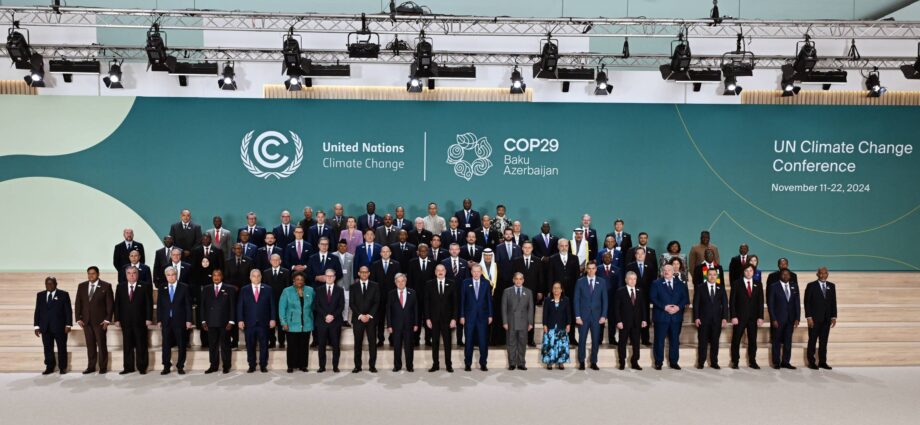
Joshua M. Pearce, Western University
November 27, 2024
The COP29 climate change conference has come to a close — as per normal it looks like very little will be done.
The most urgency that the United Nations can muster is pointing out that “extreme weather events [are] affecting people around the globe.” There is unlikely to be a flurry of national policy action in the wake of COP29. Its achievements, while not insubstantial, are unlikely to move the needle in any significant way.
Some people might think that a 2 C temperature rise doesn’t sound so bad — that a bit warmer world might be nice or that climate change will only affect others. This is a gravely mistaken belief which grossly under appreciates the era of global death and human misery which climate change is ushering in largely unabated.
With only tepid calls for change it is unlikely we will find a way to invest the “trillions of dollars required for countries to drastically reduce greenhouse gas emissions.”
Business-as-usual climate discourse has failed. Understanding the real human deaths caused by carbon emissions could help drive change in climate policy.
Contextualizing climate deaths
In a recent study reviewing more than 180 peer-reviewed articles — which I conducted with fellow researcher Richard Parncutt — we found that climate change could result in around one billion premature deaths by the end of the century unless serious action is taken to reduce emissions.
We refer to the basis of this estimate as the 1,000-ton rule.
The 1,000-ton rule states that a person is killed every time humanity burns 1,000 tons of fossil carbon. A 2 C temperature rise equates to about a billion prematurely dead people over the next century. These people will be killed as a result of a wide range of global warming related climate breakdowns. The carbon budget for 2 C of human-caused warming is about one trillion tons.
These findings were derived from a review of the climate literature that attempted to quantify future human deaths from a long list of mechanisms. This is a staggering prediction of human suffering, though however uncomfortable it may be, it is consistent with diverse evidence and arguments from multiple disciplines.
The old scientific ways of communicating about climate change simply do not work.
Policymakers and scientists have had trouble explaining even relatively basic ideas like climate forcing, the magnitude of a terraWatt, or just what exactly is a ton of carbon dioxide.
It is not necessarily that most people are ignorant, just that these ideas are often too abstract to have any real meaning for most.
Dead bodies, however, we understand. The 1,000-ton rule could serve as a simple, evocative and easily trackable framework for understanding the impact of global carbon emissions in human terms.
Put another way, by focusing on the number of people who will die and not just how much carbon has been emitted we may be able to more effectively galvanize emissions reductions efforts.
Fatalities of climate change
Heat waves have already caused thousands of human deaths by a combination of heat and humidity and even threaten the health of unborn babies.
Meanwhile, the crop failures, droughts, flooding, extreme weather, wildfires and rising seas caused by rising temperatures are also highly lethal to human populations. Crop failures, in particular, can make global hunger and starvation worse and kill large swaths of people.
More frequent and severe droughts can lead to more wildfires. Wildfires are incredibly dangerous to both life and property, as we recently saw in Hawaii.
Droughts can also lead to contaminated water, more frequent disease and deaths from dehydration. On the other hand, climate change can also cause flooding (and crop loss), which also drives hunger and disease.
The sea level rises caused by climate change (and the resultant submersion of low-lying coastal areas) threaten the lives of billions. Climate change also increases extreme weather events, which kill and cause considerable damage to essential services such as the electric grid and medical facilities.
On top of all of this, there is evidence to suggest that climate change also indirectly increases the probability of conflict and war. Although the academic consensus on climate-change-induced war is far from settled, there is little doubt climate change amplifies stress and can cause more localized conflict.
Preventing future deaths
If we do not change course, then climate change is expected to kill one person roughly every three or four seconds continually with potentially as many as one billion people dying prematurely by the end of this century. Deaths which, it must be reiterated, will not be distributed evenly across the world.
It is essential that policymakers begin considering the number of premature deaths expected from any emissions that may result from their decision.
Knowing the number of people that will be killed by a decision to open a new coal or natural gas plant will be a powerful nudge towards greener solutions. On the flip side, knowing that a decision to make an investment in carbon-zero solutions will save potentially thousands of lives will further incentivize carbon-friendly decision-making.
As world leaders decide how to follow up on COP29, they would do well to remember that their decisions are directly responsible for killing real human lives. Perhaps, the numbers just might be staggering enough for policymakers to intervene.
Joshua M. Pearce, John M. Thompson Chair in Information Technology and Innovation and Professor, Western University
Subscribe to our newsletter.
This article is republished from The Conversation under a Creative Commons license. Read the original article.

